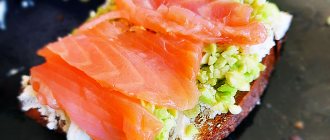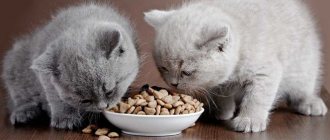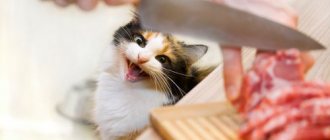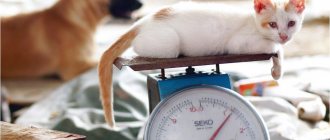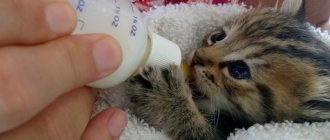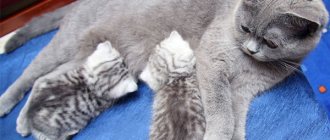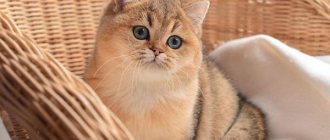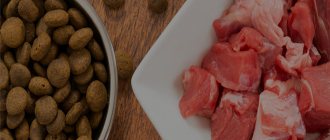12636Administration
2
British cats are affectionate and kind animals. They are sociable, love company, and get along well with children. But they don't like too much attention. Often goes to a new home, a British kitten at 2 months. Such an amazing age to have a baby.
He is old enough to start learning to eat on his own. It's time to take up his education, accustom him to the tray, explain what is possible and what is not. But do not forget that the British cat is still very small and you need to correctly and responsibly approach the issue of its further development as a full-fledged, adult cat.
Nutritional features of a 2 month old British kitten
Question: “What should I feed a British kitten for 2 months?” is very relevant for the caring owners of the child, because the kitten has just been weaned from its mother’s milk and given into adulthood. You need to start feeding your baby gradually. First comes bait 6-8 times a day, in small portions.
The diet of a British two-month-old kitten should be as follows: tender beef meat, milk, cottage cheese in its pure form, cream, cereals with milk, special canned food for kittens designed for its age.
Photo of a British baby at 2 months © shutterstock
For further transfer to dry food, 100% wet food is used, with an admixture of dry food, so that the Briton gets used to the taste of such a menu. It is best to feed British kittens for 2 months at the same time. Don’t forget, it’s important to always have fresh water near the bowl. Food should be 27-30 degrees.
Wet diets
Wet food for kittens is produced by the same companies as dry food. Breeders recommend canned food for little British dogs from:
- Gourmet Gold;
- Gimpet;
- Royal Canin.
Dry and wet food can be mixed. For example, the diet uses 75% dry and 25% canned. The amount is calculated based on the daily norm. For kittens that will participate in exhibitions, the percentage of wet food is increased to half the daily dose.
When choosing between dry and wet food, preference is given to dry food, since the granules help strengthen the teeth, clean them of plaque, and massage the gums.
It is not recommended to mix natural and ready-made food, although some breeders give natural food in the morning, and dry food is poured nearby, which the kitten eats throughout the day. This is convenient when the owner has to be away for a long time and is not sure that natural food will not spoil.
Rules
Don’t throw the beef in one solid piece, hoping that the predator will figure out what to do with it. Raw beef needs to be cut into small pieces or put into a meat grinder. Before this, it must be deep frozen for 24 hours, or it must be doused with boiling water. For a 2-month-old British kitten, choose high-quality food.
It is advisable that the canned food and food be from the same company. This way he will get used to the food faster.
What should not be included in the diet of British kittens at 2 months old? Also a relevant question. Must not be:
- Pork (fatty meat, contains a lot of bacteria, difficult to digest);
- Fish from the river (lots of small bones, the question of the purity of the water in which it was found, feeding raw fish is generally prohibited);
- Onions (dangerous for cats in any form);
- Sweets (we never sweeten food);
- Salty (we never salt food);
- Smoked meats;
- Dry food (they like it, but it is very harmful at this age in its pure form).
Natural products for the British
If the owner decides to feed the kitten natural products, then he should know what British breeders and veterinarians recommend. A cat's diet should include:
- Lean beef . The meat is pre-frozen for 3 days in the freezer or fresh meat is doused with boiling water. The prepared pieces are passed through a meat grinder. For one daily serving, a kitten needs at least 30 g of ground beef. It can be given to your baby daily.
- Beef by-products . They can be prepared in the same way as meat - frozen or boiled. Heart, lungs and kidneys are introduced into the diet no more than 2-3 times a week, and liver should not be introduced more than once, as it can cause diarrhea.
- Chicken by-products . They must be boiled to avoid infecting the kitten with salmonella. The frequency is the same as when feeding beef by-products.
- Chicken's meat . The fillet is boiled and ground. Before serving, the minced meat is diluted with chicken broth to the consistency of liquid puree. This dish is given to the baby 3-4 times a week.
- Fish - only sea fish fillets are recommended, since it contains more omega acids and is less likely to infect the kitten with worms, but nevertheless it must be boiled. Give it no more than once a week. Fish is dangerous for castrated or sterilized animals, as it causes the formation of kidney stones.
- Boiled egg yolks Allowed a maximum of a couple of times every 7 days.
- Milk – until 3 months of age, is boiled and given daily, provided that it does not cause diarrhea. For kittens, you can prepare milk porridge from semolina, oatmeal, and rice, which is flavored with a drop of honey.
- Fermented milk - yogurt (only natural, without any additives), kefir, yogurt, fermented baked milk, non-acidic cottage cheese, sour cream or cream. All products should be of medium fat content. Fermented milk products 3-4 times a week are enough.
- Porridge – cooked in water. They are mixed with boiled vegetables, meat or fish.
- Vegetables – given raw or boiled, grated or put in a blender. They can be combined with meat and fish in a 1:2 ratio (the smaller part is allocated to vegetables).
To improve digestive processes, sprouted grains of wheat and oats, as well as specially grown grass, are suitable. To make your baby's coat shiny, brewer's yeast is added to food 3-4 times a week.
Cooked food should be warm, since the mucous membranes of kittens are very sensitive. If food is prepared for 1-2 days, then the portions are packaged separately and placed in the freezer. Before serving, they are defrosted and slightly warmed up. But the products listed above cannot be given at every age.
Necessary supplies for a new family member
To make your little one feel comfortable in your home, you need to carefully prepare. Buy for him:
- a house where he will sleep and relax if he wants to be alone;
- bowls for water and food;
- toys;
- pet carrier;
- buy food;
- tray and filler for it.
It is better to take plastic carriers. Despite the fact that the plastic one is very bulky during transportation, it holds its shape perfectly and if something happens, the animal will be comfortable there.
So that the British cat has his own corner for relaxation, buy him a sleeping place, or make it yourself. Take an unnecessary box from under furniture, equipment (in terms of volume it should allow the cat to lie stretched out). Make a hole for the entrance, cover the bottom of the box with an old jacket, a pillow, and place it in a cozy corner.
There should be at least two bowls. For water and food. Keep the water fresh.
Buy a special post where you can sharpen the claws. If you have an old frame or piece of wood, make it available to the kitten.
Dry industrial feed
When choosing this type of food, you should choose food from the premium or super-premium classes. Breeders of British cats recommend food from well-known companies - Hills, Royal Canin, Nutra Gold, Purina Pro Plan. Among the recommended ones:
- NATURE'S PROTECTION KITTEN;
- NATURE'S PROTECTION SUPERIOR CARE LARGE CAT KITTEN;
- ACANA WILD PRAIRIE;
- ACANA GRASSLANDS CAT & KITTEN;
- 1ST CHOICE KITTEN.
The packaging should be marked “for kittens.” Some companies produce food specially designed for the British, for example, British Shorthair KITTEN from Royal Canin. It is impossible to feed babies with adult food, since they have different needs for useful minerals, and the size of the granules is not designed for small mouths.
Getting used to a new place and training to a tray
At first, the kitten will miss its previous home, meows at night, pick it up and stroke it, talk to it. Caring for British kittens at 2 months is exactly like this. At night, you can put him on a warm heating pad, wrapping it in a towel (this will remind him of his mother or the presence of other kittens nearby). Take your time, let the Brit get comfortable.
© shutterstock
If the animal was purchased from a nursery, they are often already litter box trained. If not, then it won't be difficult. After feeding, take your Brit to the toilet. It is better to fill the tray with wood filler. He will like it there and will quickly remember where to go. The tray should always be clean, this is the key to avoiding embarrassment. If there is an embarrassment, then it is worth punishing the kitten.
You shouldn't hit the kitten; a loud sound or clap is enough to make it scared; you can spray it with water.
This will develop a conditioned reflex and after the third time the kitten will understand that this is not worth doing. Never allow a cat's unacceptable behavior to go unpunished.
What not to feed a British kitten
After studying the nutritional information, one question remains: what should you not feed your British kitten?
Prohibited products:
- sweet, smoked, fried dishes from the human table;
- river fish with a lot of bones;
- fatty meat, potatoes, legumes;
- milk after reaching six months;
- budget food made from second-class raw materials.
The British cat is a noble, wayward breed. For a healthy appearance, soft, thick coat, it is recommended to adhere to feeding rules. If there is no opportunity and desire, then the British are the wrong breed.
Meeting all family members
Children love animals very much and show great interest in them. Tell your child how to properly pick up a cat, how he shows his dissatisfaction by wagging his tail, and that you shouldn’t squeeze him too hard and drag him around the house.
Perhaps you have another animal at home? Then you should initially not introduce the new guy to the old one for a couple of days. The new one will still get used to it, but the old resident will already feel the emergence of a new one. At the same time , pay sufficient attention to both the first and second pet so that jealousy does not arise. Arrange a meeting with them in a few days. They need to be in the room at this moment, and each of them should have a place to retreat, in case something happens. If an undesirable reaction occurs, limit contact with the animals for a couple of days and introduce them again.
Sample menu by age
The nutrition of kittens changes as they grow, so the owner needs to know an approximate menu by age. The list of products in it is conditional, it is allowed to diversify it, which will benefit the pet.
Up to a month
Up to a month, kittens are usually fed by the mother with her colostrum and milk. She calculates the frequency of feeding herself for her offspring. The secretion of the mammary glands is the most suitable food for newborn kittens. It contains everything you need to create strong immunity.
Sometimes the mother cannot or refuses to feed the cubs. Then the owner will have to fatten the pets. For this purpose, a cat's milk replacer is used. The number of feedings and method of breeding are indicated on the packaging. Usually replacements are given for up to 4 weeks.
1 month
When the kitten is 1 month old, it is advisable to continue feeding it with mother's milk. If this is not possible, then a high-quality substitute. Then there is a smooth transition to solid food.
Basic Rules:
- Start introducing dairy products into your diet, but raw cow's milk is not recommended. The best option is infant formula.
- Include meat in your diet with boiled finely chopped beef or, better yet, veal.
- Gradually include porridge made from buckwheat, semolina or oatmeal.
- At the end of the first month, introduce fermented milk products: cottage cheese, yogurt.
- Give boiled liver 1-2 times a week.
Safety first
Take care of the safety of the chosen toy for your kitten, because they are like children. There should be no parts that a Briton can swallow: excess fluff, elastic, shiny, small beads. Toys should be soft and made of good fabric. Avoid purchasing hard or sharp toys.
Make sure everything in the house is safe for the kitten:
- Close access to all the cracks where a Briton can climb in and not get out until he grows up;
- Keep the bags out of the reach of kittens, because they are such little naughty creatures, while playing, they can get stuck there and suffocate;
- Cover your trash at night. A British person will not be tempted to find and eat a sausage roll;
- Place nets on the windows so that the Briton does not stare at the bird and fly away with it;
- Don’t leave threads, raindrops, or balls in a place accessible to a Briton; he can easily eat it all;
- While the Briton is very small, be careful. He remembers that you may not notice him, step on him, sit down, lie down;
- Before the first vaccination, try to limit your pet’s contact with other animals and various objects from the street;
- Do not leave chemicals or detergents open or unattended;
- It is better to keep dry food in the pantry away from the cat.
The importance of water in the British diet
For British cats, and even more so kittens, water is an important substance necessary for the normal functioning, growth and development of the body. It is required in moderation. If wet food was chosen for feeding, then less water will be needed.
Main conditions:
- constant access to a bowl of water;
- keeping it clean;
- change the liquid every day or more often if pieces of food or other objects get into the container;
- placing a bowl of water separately from the container with food.
Ordinary tap water is suitable for drinking, as long as it has no foreign odor or taste . It happens that a cat refuses to drink tap water, then filtered or purchased drinking water is taken.
Animal hygiene and vaccination
Britons also need to be brushed regularly. A rubber, oval brush is perfect for this task. They will not only remove excess hair, but also give a light massage and remove static tension from the British dog’s coat. Their fur is not long, it does not gather in lumps, and there are no difficulties in grooming.
© shutterstock
In winter, you need to touch the wool with a wet hand to create moisture, because... The air is especially dry during the heating season, and the wool fades against its background.
You can bathe your British cat once every six months, with a special shampoo. Water 40 degrees. After bathing the cat, wrap it in a towel and dry it, making sure that it does not catch a cold. Check the ears every week for cleanliness; if there is excess wax, carefully remove it with a bath stick soaked in hydrogen peroxide.
How to feed a pregnant cat
It's time to figure out how experts feed a cat in an interesting situation. By and large, no dramatic changes have been observed, but some nuances should be mentioned:
- As for beef, it is worth treating the expectant mother with it more often. And this means not only the meat itself, but also the liver and heart.
- pregnant cat should absolutely not eat a lot. The saying that you need to “eat for two” is one of the most dangerous myths. If there is an excess of food, especially high-calorie food, too large fetuses will form in the cat’s womb. As a result, childbirth may become more difficult than with a reasonable approach to diet planning.
- If the owner pampers his pet with dry food, it is important to take care of minor adjustments to the menu. Preference should be given to special foods for pregnant women. For example, “Royal Canin QUEEN” has earned good fame.
Vaccinations
Do not forget that the British breed was bred almost artificially. Animals of this breed have weak immunity. Don't neglect vaccinations ! In fact, this is very important. Already in the period from two to three months, a kitten can be vaccinated. This will protect him from many diseases. Before visiting the veterinarian, give your pet an anthelmintic drug ten days in advance; if after ten days no helminths are found, then you can safely visit the veterinarian.
After the first vaccination, the second one is given, exactly twenty-one days later. The same vaccine is administered, and after fourteen days immunity is developed. Repeated vaccinations are recommended every year.
Basic feeding rules
First of all, it’s worth understanding the basic rules of catering:
- The most common mistake made by owners is mixing natural and dry food. There is a misconception that adding meat, fish or vegetables to your cat's favorite bag will have a beneficial effect. In reality, this approach can be fraught with problems with the gastrointestinal tract and urinary system.
- Some owners follow the above rule, but sometimes allow exceptions. For example, when choosing mostly natural food, sometimes they treat their pets to purchased food as a reward for something. Such feeding is also extremely undesirable, because different types of food are digested differently.
- The cat should not remain hungry for more than 2-3 days. This is extremely important to consider when planning to be away from home for a long time.
- Cats and dogs should have different diets. The fact is that the latter synthesize some amino acids independently. But the heroes of this article cannot do this, so the owner of both animals must take into account. Therefore, you will have to abandon the same nutrition plan.
- If the cat is fed natural food, you should think about an additional dose of vitamins. Dry food is balanced in advance, but fans of natural food will have to balance it themselves.
- Whatever type of food is chosen, it must be served warm. Of course, the meal should be stored in the refrigerator, but it should be reheated before serving to your pet.
- Cat rations should not be given “while the pet is eating,” but based on the following proportions: kittens - 10% of their weight, adults - 5%.
Reasons for addiction to milk
First of all, milk is a tasty product. The cat understands perfectly well that milk contains a huge dose of protein, which is easily absorbed by the body not only of animals, but also of humans. In addition, milk contains a decent range of essential vitamins, methionine and choline (improves liver function) and calcium, which is an essential element in building strong bones. That is, milk is not only tasty, but also a healthy product.
Now we need to figure out whether it is possible to give milk to a cat?
And why is there an opinion that this product should not be included in a pet’s diet? The fact is that milk contains lactose. It is a sugar that consists of one molecule of glucose and a molecule of galactose. This element is present exclusively in milk. Lactase is a special enzyme that breaks down lactose into its individual components, which are then easily absorbed by the human body.
Lactase is produced in the cells of the mucous membrane of one of the intestinal sections. The amount of lactase in a cat’s body is at its maximum during childhood. However, over time, the concentration of the enzyme decreases due to age-related changes in the animal’s body.
This is a signal to stop milk consumption. The diet of an adult cat is somewhat different from the diet of an infant cat. But just in case, lactase continues to be produced in the pet’s body. But every cat is different. Contrary to popular belief, lactase production does not stop completely after the animal has matured.
In practice, it turns out that some cats drink a lot of milk, while others cannot tolerate it at all. Then their owners immediately perceive it a little differently. It is necessary to correctly assess the reaction of a pet to milk. If a cat has diarrhea, then they consider milk to be harmful. If the cat drinks milk with pleasure, then it will be useful, according to the owners.
Such owners will immediately begin to buy dairy products for their pet, although some of them may not be accepted by the animal’s body. In addition, a cat may love fermented milk products, but due to the characteristics of the body is not able to consume them. Therefore, you should carefully monitor your pet’s vital activity to determine its food preferences.
It should be noted that diarrhea is caused by a deficiency of the lactase enzyme in the animal's body. Lactose, which the body does not digest, binds water, thus causing diarrhea. And intestinal bacteria contribute to the fermentation of sugar, which causes the cat to experience colic and a bloated belly.
It is also possible that with a small dose of milk such problems may not arise. But it is best not to give milk to an animal whose body does not produce lactase in the proper concentration. This makes sense because milk companies have now been able to create lactose-free milk (the animal's body does not need to digest lactose by using lactase).
Such products have long been sold to people suffering from a similar problem.
Many people advise using goat's or sheep's milk instead of cow's milk, since it contains less lactose. The lactose concentration in cow's milk is 4.6%, in goat's milk - 4.5%, and in sheep's milk - 4.8%. Statistics show that you should not listen to the advice of others.
It is worth noting that cats, like people, can be intolerant to the protein found in cow's milk. This is called a milk allergy. In this case, it may be advisable to consume goat’s milk, which does not contain proteins that cause allergies.
More details about fermented milk products
Milk begins to ferment under the influence of lactic acid bacteria, yeast and fungi. Once in the animal’s body, all these components react with pathogenic microorganisms, increasing the level of the body’s defenses and eliminating various types of diseases.
Based on this, fermented milk products should occupy the top line in a pet’s diet. At least not a single cat’s natural diet is devoid of such products as cottage cheese, yogurt and kefir. But how do lactic acid bacteria act on milk so that it immediately becomes beneficial?
